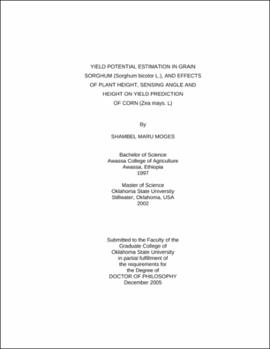| dc.contributor.advisor | Raun, William | |
| dc.contributor.author | Moges, Shambel Maru | |
| dc.date.accessioned | 2013-12-10T18:04:36Z | |
| dc.date.available | 2013-12-10T18:04:36Z | |
| dc.date.issued | 2005-12 | |
| dc.identifier.uri | https://hdl.handle.net/11244/7739 | |
| dc.description.abstract | Scope and method of study: For chapter one, grain sorghum (Sorghum bicolor L. Moench) experiments were conducted to estimate the yield potential of grain sorghum at different nitrogen levels using a self illuminated had held optical sensor. A total of six experiments with four levels of nitrogen (50,100,150,200 kg ha-1) and there types of applications were arranged in a randomized complete block design in three replications. Sensor readings were taken at five different growth stages (2, 3, 5, 6 and 7). For the second chapter, in one set, a total of 20 transects of corn (Zea mays L.) each with 20 m length were used to estimate the relationship of plant height and grain yield. Plant height was measured at there different growth stages (V8, VT and R1) from the ground to the tip of extended last collar leaf at V8 and up to the base of the last collar leaf at stages VT and R1. In the other set, a total of four transects (50 plants each) were used to determine the effects of sensing height and angle on sensor readings and grain yield. Sensor measurements were taken at stages V8, VT and R1 and used to estimate the relationship of by-plant NDVI and grain yield. | |
| dc.description.abstract | Findings and Conclusions: For chapter one, over years and locations, grain yield was not significantly affected by N application methods. Sorghum has shown a response to N but there were no significant differences among treatments in 2004. Significant linear or quadratic responses were observed in 2005 for irrigated sites. Simple linear regression analysis showed that grain yield was highly related to green and red NDVI and INSEY at growth stage 3, with green slightly better than red. The results of this experiment has indicated that INSEY could be used as a good predictor of sorghum yield at growth stage 3. For the second chapter, plant height was highly related to grain yield at VT over locations and years. The data suggested that including plant height as one of yield prediction component can improve corn yield prediction model. Also sensor measurements taken at 0.76 m and nadir position have shown a better relationship with grain yield and NDVI at corn growth stage VT. | |
| dc.format | application/pdf | |
| dc.language | en_US | |
| dc.rights | Copyright is held by the author who has granted the Oklahoma State University Library the non-exclusive right to share this material in its institutional repository. Contact Digital Library Services at lib-dls@okstate.edu or 405-744-9161 for the permission policy on the use, reproduction or distribution of this material. | |
| dc.title | Yield potential estimation in grain sorghum (Sorghum bicolor L.) and effects of plant height, sensing angle and height on yield prediction of corn (Zea mays L.) | |
| dc.contributor.committeeMember | Zhang, Hailin | |
| dc.contributor.committeeMember | Solie, John B. | |
| dc.contributor.committeeMember | Stone, Marvin L. | |
| osu.filename | Moges_okstate_0664D_1630 | |
| osu.accesstype | Open Access | |
| dc.type.genre | Dissertation | |
| dc.type.material | Text | |
| thesis.degree.discipline | Soil Sciences | |
| thesis.degree.grantor | Oklahoma State University | |
